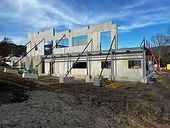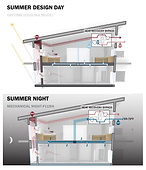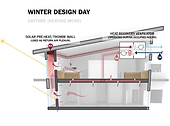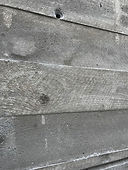
Nominee
Connecticut DEEP Western Headquarters, Black Rock State Park, Watertown, CT

Category
Innovative Project
Description
O&G Industries Inc., an NRMCA member, is the concrete vendor for the new Connecticut Department of Energy and Environmental Protection (DEEP) Western District Headquarters at Black Rock State Park in Watertown, Connecticut. This building will be the first net-zero and LEED Platinum building built by the State of Connecticut.
The new headquarters will bring DEEP staff together from several facilities throughout the Western part of the state, consolidating staff from 9 outdated buildings located in five separate towns. This consolidation will save energy, money and increase efficiencies, and will result in the decommissioning of upwards of 11 buildings.
The new main building will be designed to achieve LEED Platinum certification and Net Zero energy standards. The building will use a geothermal system and a photovoltaic solar array, among other features, which will result in a 30-40% reduction in energy consumption when compared to a building designed to current building and energy codes. The building will be finished with wood grown from CT State Forests and milled at CT DEEP’s sawmill.
To further reduce the carbon footprint of the facility, the design plans call for forty percent cement replacement in the structural concrete mixes with environmentally friendly Pozzotive®. Pozzotive is a high-quality ground glass pozzolan made from 100% recycled post-consumer glass. It is a safe, sustainable, and high-performing pozzolan that dramatically reduces embodied CO2 emissions in concrete.
The new headquarters aligns with the state’s goals to mitigate the climate crisis and for State Government to lead by example to identify opportunities for savings and ways to make government operations more sustainable.
Evidence
From Michael Fortuna, AIA, of TLB Architecture, LLC
The building is designed to achieve LEED Platinum status, as well as to be net-zero, with carbon-free operation. A fully integrated approach to building systems and assemblies was required to maximize efficiencies and minimize environmental impacts.
It became clear that an approach that included a thermal mass wall would optimize the site’s solar orientation to reduce overall energy consumption. A Trombe wall was designed to provide passive heating during the winter months, passive cooling during the summer, and improved natural ventilation. Working in conjunction with earth sheltering, photovoltaics, a geothermal system, radiant polished concrete slabs, and a carefully designed building envelope, the building’s energy consumption will be significantly lower than a comparably sized traditional building.
The next challenge was to determine how to minimize the carbon impact of the concrete production. With cement accounting for 88% of the carbon emissions associated with concrete, a targeted approach at reducing cement content in the concrete mix was required. Concrete mixes utilizing traditional pozzolans, such as fly ash and slag move the carbon reduction in a favorable direction but have impacts of their own.
Pozzotive, high-performance ground glass pozzolan was evaluated to determine its effectiveness, availability, and carbon reduction potential. Various mixes were evaluated, and it was determined that a 40% replacement of the cement content with Pozzotive would yield the strength required for the structure, workability and a significant reduction in Global Warming Potential.
Some key benefits of Pozzotive ground glass pozzolan include the following:
1. Manufactured in CT, about 16 miles from the site, which further reduces embodied carbon.
2. Manufactured from 100% post-consumer glass sourced within a 50-mile radius
3. Non-toxic, contains no crystalline silica or heavy metals, and no known carcinogens present in other Pozzolans.
4. Lower water: cement ratio results in stronger concrete with reduced cement content.
5. Independent testing shows a Global Warming Potential (GWP) of Pozzotive is 56kg CO2e, compared to an industry average GWP for cement of 1,040 kg CO2e, resulting in 95% less impact than the industry average cement.
Images (click to expand)








